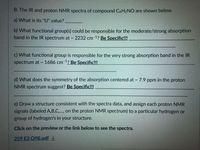
Organic Chemistry
9th Edition
ISBN: 9781305080485
Author: John E. McMurry
Publisher: Cengage Learning
expand_more
expand_more
format_list_bulleted
Concept explainers
Question

Transcribed Image Text:B. The IR and proton NMR spectra of compound C9H¬NO are shown below.
a) What is its "U" value?
b) What functional group(s) could be responsible for the moderate/strong absorption
band in the IR spectrum at 2232 cm-1? Be Specific!!!
c) What functional group is responsible for the very strong absorption band in the IR
spectrum at
1686 cm 1? Be Specific!!!
d) What does the symmetry of the absorption centered at - 7.9 ppm in the proton
NMR spectrum suggest? Be Specific!!
e) Draw a structure consistent with the spectra data, and assign each proton NMR
signals (labeled A,B,C., on the proton NMR spectrum) to a particular hydrogen or
group of hydrogen's in your structure.
Click on the preview or the link below to see the spectra.
259 E3 Q9B.pdf

Transcribed Image Text:WAVENLMRO CR
70
註
12
WAYTLENGTH IN MOONS
14
墨
Expert Solution
This question has been solved!
Explore an expertly crafted, step-by-step solution for a thorough understanding of key concepts.
Step by stepSolved in 2 steps with 1 images

Knowledge Booster
Learn more about
Need a deep-dive on the concept behind this application? Look no further. Learn more about this topic, chemistry and related others by exploring similar questions and additional content below.Similar questions
- Determine the following for the compound C6H15N a.) degrees of unsaturation b.) Assign the principal IR absorption bands above 1500 c.) draw the structure of the compound d.) label the protons on your structure with letters and assign them to peaks on the NMR spectrum.arrow_forwardConsider the product below a) Predict the 1H NMR spectrum for this molecule. Predict the multiplicity, integration and relative ppm b) Predict the 13C NMR spectrum and DEPT spectra. Use (+) for positivesignals, (-) for negative signals, and (X) for no signal in the DEPT NMR spectra.arrow_forward1B. Can 1H NMR spectroscopy be used to differentiate between the two compounds? Briefly explain why or why not. Predict the 1H NMR spectrum for each compound (include integration, multiplicity, and approximate chemical shift). Put it in data table format.arrow_forward
- III) Can 1H NMR spectroscopy be used to differentiate between the two compounds? Briefly explain why or why not. Predict the 1H NMR spectrum for each compound (include integration, multiplicity, and approximate chemical shift). For each set, be sure that you put them in a data table format!arrow_forwardBelow are the spectral data (IR, MS, 1H NMR, and 13C NMR) for an unknown organic compound. Examine the data carefully and answer the questions that follow.4a) There is only one set of signals above 1750 cm–1 in the IR spectrum. What functional group does this signal indicate? 4b) Combining information from the IR and NMR spectra, what major functional group is likely present? 4b) How many signals from sp3 carbons in 13C-NMR 4c) How many different proton chemical environments are in the molecule? 4e) Proposed structurearrow_forwardPlease show work 1. Compound A has molecular formula C5H10O. It shows three signals in the 1H-NMR spectrum - a doublet of integral 6 at 1.1 ppm, a singlet of integral 3 at 2.14 ppm, and a quintet of integral 1 at 2.58 ppm. Suggest a structure for A and explain your reasoning.arrow_forward
- Than5 you!arrow_forwardDetermine the structure of a compound with the formula C11H15ClO2 based on the 1H NMR spectrum below. Based on its 13C NMR (DEPT) spectrum, it is evident that this molecule shows 9 signals including one methyl (CH3) and four methylene (CH2) units.arrow_forwardcompound with formula C9H10O. If the unknown has an IR absorption at 1690 cm–1 please tell me structure ??arrow_forward
- I have an NMR spectrum. There are 5 peaks. There is a doublet at 9.6 ppm (integrates to 2H) where aldehydes usually arise, don't know why there is a doublet. There is another doublet at 6.8 ppm, again integrating to 2H. There is a singlet at 4.5 ppm, integrating to 1H. There is a quartet at 3.4 ppm integrating to 2H, and lastly there is triplet at 1.2 ppm integrating to 3H. i recofnize the ethyl group but don't understand the peak at 9.6 unless it is not an aldehyde.arrow_forwardPredict (draw) the ¹H NMR and 13C NMR spectra for each molecule. Your illustration should include chemical shift, integration, and splitting (where appropriate). Label each signal in your spectrum a, b, c... etc and label the corresponding C/H atoms in each molecule. CIarrow_forwardHi there...can u please answer for question a, b & c. Thanks in advancearrow_forward
arrow_back_ios
SEE MORE QUESTIONS
arrow_forward_ios
Recommended textbooks for you

 Organic Chemistry: A Guided InquiryChemistryISBN:9780618974122Author:Andrei StraumanisPublisher:Cengage Learning
Organic Chemistry: A Guided InquiryChemistryISBN:9780618974122Author:Andrei StraumanisPublisher:Cengage Learning Organic ChemistryChemistryISBN:9781305580350Author:William H. Brown, Brent L. Iverson, Eric Anslyn, Christopher S. FootePublisher:Cengage Learning
Organic ChemistryChemistryISBN:9781305580350Author:William H. Brown, Brent L. Iverson, Eric Anslyn, Christopher S. FootePublisher:Cengage Learning


Organic Chemistry: A Guided Inquiry
Chemistry
ISBN:9780618974122
Author:Andrei Straumanis
Publisher:Cengage Learning

Organic Chemistry
Chemistry
ISBN:9781305580350
Author:William H. Brown, Brent L. Iverson, Eric Anslyn, Christopher S. Foote
Publisher:Cengage Learning